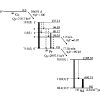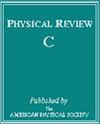Precise measurements of the γ-ray intensities following the β decay of Ce144 and Nd147
IF 3.4
2区 物理与天体物理
Q1 Physics and Astronomy
引用次数: 0
Abstract
For many fission products, the rays emitted following decay provide an easily detectable signature that can be used to identify their quantities and distributions in a sample. As a result, -ray spectroscopy is often exploited to study fission-product yields, provided sufficiently accurate information on the -ray intensities is available. In many cases, the uncertainties in the existing nuclear data are large enough that they compromise the precision achievable for modern experiments and applications. In this paper, we present high-precision results for the absolute -ray emission intensities for the most intense transitions in the decays of and . We measured these intensities to accuracy by producing radiopure samples with fission-product beams at CARIBU and detecting the emitted radiation with a counter and a meticulously efficiency-calibrated high purity germanium detector at Texas A&M University.

精确测量 Ce144 和 Nd147 β 衰变后的γ 射线强度
对于许多裂变产物来说,β衰变后发射的γ射线提供了一个易于检测的特征,可用来确定它们在样品中的数量和分布。因此,只要有足够准确的 γ 射线强度信息,γ 射线光谱法经常被用来研究裂变产物的产量。在许多情况下,现有核数据的不确定性足够大,以至于影响了现代实验和应用所能达到的精度。在本文中,我们给出了 Ce144 和 Nd147 β 衰变中最强烈跃迁的 γ 射线绝对发射强度的高精度结果。我们在卡里布大学用裂变产物光束制造出了辐射纯样品,并在德克萨斯A&M大学用4πβ计数器和经过严格效率校准的高纯锗探测器探测了发射的辐射,从而测量了这些强度,精确度达到了≲1%。
本文章由计算机程序翻译,如有差异,请以英文原文为准。
求助全文
约1分钟内获得全文
求助全文
来源期刊

Physical Review C
物理-物理:核物理
CiteScore
5.70
自引率
35.50%
发文量
0
审稿时长
1-2 weeks
期刊介绍:
Physical Review C (PRC) is a leading journal in theoretical and experimental nuclear physics, publishing more than two-thirds of the research literature in the field.
PRC covers experimental and theoretical results in all aspects of nuclear physics, including:
Nucleon-nucleon interaction, few-body systems
Nuclear structure
Nuclear reactions
Relativistic nuclear collisions
Hadronic physics and QCD
Electroweak interaction, symmetries
Nuclear astrophysics
 求助内容:
求助内容: 应助结果提醒方式:
应助结果提醒方式:


